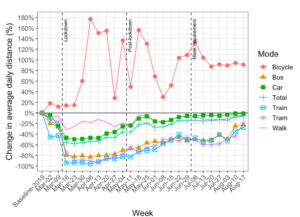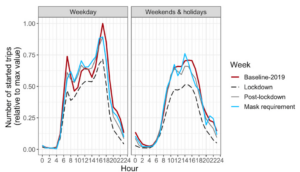Kristóf Sárosi
Flexible working has been in the cards and has been studied for decades, but only COVID-19 could show that we are ready for it. Could technology reduce the distance travelled, traffic at peak hours, the stress level of employees, and reduce office space?

On the sofa at home or at your standing desk in your office? [ingenieur.de]
(Un)fortunately, we did not have to wait for managers to realize that it is indeed possible for many of us to work from home in the digital age. The pandemic in 2020 turned our life upside down but also showed us that technology is there to work, teach and share ideas in the digital space.
SDGs
Among many other institutions, OECD (2020) have argued that hybrid work needs to be integrated into business and governmental planning. This leads to opportunities for achieving the goals set by the United Nations in the Sustainability Development Goals. Telework has also been introduced as an integral part of the green recovery plan after COVID-19. Not only can it reduce emissions, and improve work-life balance but it was the most important tool to slow down a pandemic and not crushing the economy at the same time. The question is if hybrid work or telework is going to be an integral part of our lives, leading to a more sustainable future.
The number of papers on relations between teleworking (home office) and the SDGs has increased since the pandemic. This indicates that teleworking has become part of our lives and that researchers believe that introducing home office on a broader level has effects on our society. SDGs are widespread, reflecting on many aspects of our lives, therefore it is not hard to find an aspect that teleworking has an effect on.
Moglia et al. (2021) made a thorough analysis of how teleworking relates to sustainability and especially SDGs. In their scope review, they studied previous claims and research on the effects of teleworking. Their take-home-message was the following:
In the following, I would like to present a few of these issues, using research results on the given topics.
Effects on traffic
It is well documented that living in a major city can shorten the life of a citizen, and lead to respiratory diseases due to the high level of airborne particles and pollutants, that are caused by the traffic and industry inside the city. If there is any way we can reduce the traffic in a city, it leads to a better life quality of its citizens not only physically but also mentally.
Regarding environmental impact, the most important aspect of flexible working is the reduced commute of employees. We all know that we should avoid driving in the city during rush hours, but we should also think about how we could avoid having this phenomenon in the first place. In Switzerland, there was no confinement in place during COVID-19 but the mandatory home office, closed schools and universities, and closed businesses lead to extremely reduced mobility. Molloy et al. (2021) used a tracking app to observe the mobility of volunteers in 2019 and used the same technology on the same people during the pandemic.

Weekly change in average daily km travelled. Molloy et al. (2021)
We can see that during the first lockdown, the number of cyclists increased significantly, while the number of kilometres covered by cars reduced. As people started going back to the office, pupils returned to schools after the lockdown, and the milage of cars has recovered to the pre-pandemic level. Their survey showed that biking was used primarily as a leisure activity rather than a new form of commuting, which explains the increased numbers amid the unchanged mileage of cars. An interesting finding of the paper was the reduced and less significant peak hours during the day. As many kept working in hybrid mode or their working time became more flexible, the number of car trips has reduced by 20% in the rush hours. During this period, schools were either closed or had summer break for a significant period.

Car travel hourly counts. Molloy et al. (2021)
The study only concentrated on the number and type of commuters, not drawing any conclusions on the environmental impact of the changed traffic. During COVID-19, we have seen the news about how the reduced global and local mobility led to better air quality, improved the living environment of the flora and fauna, and hoped we learn from these.
The working environment
Your working environment is your second home, you have to sadly admit it. You spend almost as much time there as you spend at home, and it affects your daily life. And your office affects not only you but also the locals around the building and people passing through the area. With the ever-expanding office spaces and construction sites, this trend seemed to continue until the pandemic. With teleworking, many offices stayed empty and have not been used to full capacity ever since. Managing these buildings is a huge task not only for the staff but also for the environment: AC units, heating, lights, water, electronics, and waste are a few of many things that impact the environment. Reducing office spaces and slowing down their expansion are beneficiary for improving living areas in the cities.
We should not talk only about the physical impact of these places, but we have to think about the mental aspects of it. Traditionally, our working place is not our home, having a clear, physical boundary between our professional and personal life. With the pandemic, this barrier was broken, leading to problems according to Martin et al. (2022). They focused on the well-being of the employees in different firms in Luxemburg during the first lockdown. They created five profiles based on four digital tools for collaboration and communication, comparing their frequency of use before and during the lockdown. They found that the productivity of the workers increased at the cost of their job satisfaction. There have been studies in the late 20th century, claiming that telework is not good for productivity, therefore companies should avoid it. This study shows that if the employee was familiar with the tools, (s)he had fewer problems with information overload and could perform better in a teleworking environment. The alarming results are the increased stress and reduced job satisfaction levels with the long-term separation from colleges, being confined, and the problems caused by bringing their professional life to their home. Their data also shows that a significant part of the employees was more satisfied and less stressed in the home office environment.
Descriptive statistics of the evolution of subjective well-being and productivity before and during the lockdown. Martin el al. (2022)
Offices affect urban planning and the well-being of the citizens and employees, leading to the question that if we can tackle some of these issues by making home office a mandatory offer by the companies towards employees.
Outlook
After having a look at teleworking from many angles, I am convinced that policymakers should consider creating new regulations for flexible working. COVID-19 was the biggest teleworking experiment in history, and data shows promising results regardless of the extreme nature of the event. If applied wisely, I believe hybrid working can play a big role in improving life in the cities, reducing mileage, creating more accessible jobs, and most importantly: reaching a more sustainable future.
References
OECD. Productivity Gains from Teleworking in the Post COVID-19 Era: How Can Public Policies Make it Happen; OECD: Paris, France, 2020. http://hdl.voced.edu.au/10707/545307
Molloy, J., Schatzmann, T., Schoeman, B., Tchervenkov, C., Hintermann, B., & Axhausen, K. W. (2021). Observed impacts of the Covid-19 first wave on travel behaviour in Switzerland based on a large GPS panel. Transport Policy, 104, 43–51. https://doi.org/10.1016/j.tranpol.2021.01.009
Martin, L., Hauret, L., & Fuhrer, C. (2022). Digitally transformed home office impacts on job satisfaction, job stress and job productivity. COVID-19 findings. PLOS ONE, 17(3), e0265131. https://doi.org/10.1371/journal.pone.0265131
Moglia, M., Hopkins, J., & Bardoel, A. (2021). Telework, Hybrid Work and the United Nation’s Sustainable Development Goals: Towards Policy Coherence. Sustainability, 13(16), 9222. https://doi.org/10.3390/su13169222